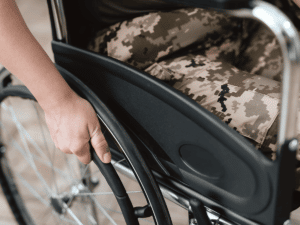The PACT Act: Veterans Benefits for Burn Pit Exposure
The PACT Act is a recently passed piece of legislation designed to help veterans who have been exposed to burn pits and other harmful materials. These veterans often suffer from a host of illnesses and conditions, all of which are considered to be presumptive (meaning the illness is assumed to have come from the exposure). The PACT Act provides these veterans with benefits and compensation for their damages. There might be a backlog to receive these benefits, but that only makes it more important to apply and seek legal advice about your specific situation as soon as possible.

What Benefits are Available to Veterans with the PACT Act
What are Burn Pits, and How are They Harmful?
During US conflicts overseas, especially in the Middle East, the military utilized burn pits to incinerate materials that might have been harmful in the wrong hands. These include things like uniforms, equipment, technology, and weapons. Not only did these items release toxic fumes when burned, but harmful gases were often released by the fuel used to burn the gear. . As a result, individuals who were in close proximity to the pits are at a heightened risk for certain illnesses and conditions, as described below.
Why the PACT Act Was Passed
Because of these health risks, the US government has set aside billions of dollars to help impacted veterans. PACT provides for both medical treatment and disability benefits for those who have been harmed as a result of their exposure to these burn pits. If you or someone you know is a veteran and has been impacted by burn pit exposure, it is important to seek legal help as soon as possible to ensure that you receive the full compensation and benefits to which you are entitled. PACT is a complicated piece of legislation, and an experienced attorney can help you navigate the process and ensure that you receive the maximum amount of compensation possible.

What are Burn Pits and How are They Harmful
Who is Eligible for the PACT Act
Veterans of the Vietnam, Gulf War, and post-9/11 eras are eligible to receive compensation as a result of the PACT Act being passed. While veterans typically have to demonstrate that their disability or condition came from their military service, the PACT Act presumes that any condition listed under the act came from the veteran's service. This means that veterans do not need to prove that their condition came from any specific thing during their service, only that they have the condition listed.
Additionally, the survivors of veterans who have passed away from one of the conditions listed by the Act may also be eligible to receive benefits. These can range from a monthly payment to a pension, so if you believe you may be eligible it could be beneficial to apply. There are a few other conditions that one must meet to receive benefits, all of which can be found on va.gov in the “The PACT Act and your VA benefits” section.
Locations Where Burn Pits Were Utilized
The following is a list of places where burn pits were used. Veterans who served in the following locations are eligible for the benefits the PACT Act provides.
- Afghanistan
- Djibouti
- Egypt
- Jordan
- Lebanon
- Syria
- Uzbekistan
- Yemen
- Bahrain
- Iraq
- Kuwait
- Oman
- Qatar
- Saudi Arabia
- Somalia
- The United Arab Emirates (UAE)
- The airspace above any of these locations
Note that the date of service affects whether or not a person is eligible to receive compensation. Relevant information about the PACT Act and its passing and the form to apply can be found on va.gov.

The PACT Act Veterans Benefits for Burn Pit Exposure
Which Illnesses are Considered Presumptive
The US Department of Veterans Affairs has put out a list of illnesses that fall under the jurisdiction of the PACT Act. These include a list of both cancers and other non-cancer illnesses, seen below.
Cancers
- Brain cancer
- Gastrointestinal cancer (any type)
- Glioblastoma
- Head cancer (any type)
- Kidney cancer
- Lymphatic cancer (any type)
- Lymphoma (any type)
- Melanoma
- Neck cancer (any type)
- Pancreatic cancer
- Reproductive cancer (any type)
- Respiratory cancer (any type)
Illnesses
- Asthma (diagnosed after service)
- Chronic bronchitis
- Chromic obstructive pulmonary disease (COPD)
- Chronic rhinitis
- Chronic sinusitis
- Constrictive bronchiolitis or obliterative bronchiolitis
- Emphysema
- Granulomatous disease
- Interstitial lung disease (ILD)
- Pleuritis
- Pulmonary fibrosis
- Sarcoidosis
In order to receive benefits, a veteran does not have to prove they were exposed to one of these burn pits, only that they have one of the above conditions. However, if you have been exposed to a burn pit, it is important to document this as it might help your claim.
What Benefits are Available to Veterans with the PACT Act
The PACT Act provides a few different benefits for veterans who have been exposed to burn pits. These benefits include:
- Disability compensation
- Health care
- Vocational rehabilitation
- Education benefits
- Home loan guarantees
- Life insurance
- Burial benefits
Receiving Your PACT Act Benefits
If you are a veteran or the survivor of a veteran and believe you may be eligible for PACT Act benefits, the first step is to gather any and all medical records that you may have. This includes both civilian and military records, as well as any documentation of your exposure to burn pits or other materials. Once you have gathered all of your records, the next step is to apply on va.gov. The application form online has information on what other things might be necessary to apply.
What To Do Now That the PACT Act Has Passed
The PACT Act can be hugely beneficial for veterans who have been exposed to burn pits and other materials. If you or someone you know meets the qualifications for the PACT Act, it is important to apply as soon as possible. There might be a backlog to receive these benefits; however, that does not mean you should not start the process. With the PACT Act, you might be able to get the benefits and compensation you deserve. The lawyers at Napolin Accident Injury Lawyer have experience getting veterans the compensation they deserve. Contact us today for a free consultation at (866)627-6546.
- Understanding Uber Accidents and Insurance Coverage Periods in California - April 8, 2025
- A Guide on Red Light Auto Accidents in California - August 14, 2024
- Self-Representing in a California Personal Injury Claim - August 13, 2024
